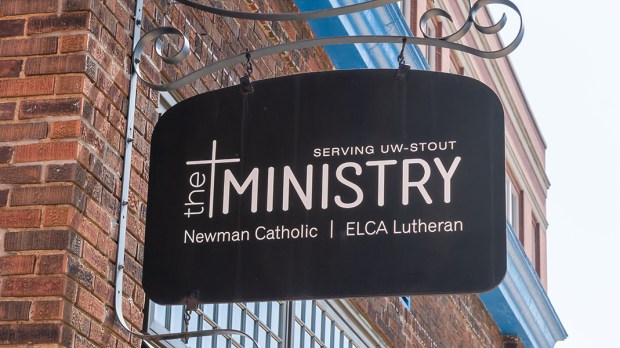An uninformed college freshman setting foot on campus for the first time might not think much about the sign on the front of the Newman Center. He could be forgiven for assuming it was named for just another wealthy donor.
In a way, he’d be right. But this benefactor had given no money to the college. What he gave was of far greater value.
The “benefactor” in this case was John Henry Newman, a canonized cardinal of the Catholic Church who was known for his significant thinking and writing about higher education — so much so that when a movement arose to provide spiritual help for Catholics studying at non-Catholic universities, it chose to operate under his name.
Cardinal Newman, an English convert from the Anglican communion, died in 1890. One of his best known books was called The Idea of a University.
At Oxford University in 1888, where Newman himself had taught, a Catholic convert named Hartwell de la Garde Grissell founded a club to support Catholic students there. He called it the Newman Society at Oxford.
Five years earlier, in Madison, Wisconsin, several Catholic students from the University of Wisconsin had gathered at the home of Mr. and Mrs. John C. Melvin for Thanksgiving dinner. During the conversation, one of the students mentioned that a professor had slandered the Church in his treatment of “medieval institutions.” This led to a debate among the students, who continued to meet at the Melvin home for discussion and fellowship, eventually forming the “Melvin Club.”
One of the members of the Melvin Club was Timothy Harrington. Later, while taking a semester break from graduate studies at the University of Pennsylvania, he reread Newman’s autobiography, Apologia pro Vita Sua. “Inspired by Newman’s ability to defend the faith and his ideas about university education for Catholic students, Harrington drew on his experience in Wisconsin and initiated the first Newman Club,” Oratorian Fr. Drew Morgan, provost of the Pittsburgh Oratory of St. Philip Neri, said in a 2010 interview with Zenit. “It followed a similar format, incorporating social activities, discussions on the faith, and mutual support for Catholic students in a frequently hostile academic environment. The meetings often became occasions for dating and debating, essentially providing a Catholic culture in a secular environment.”
The year was 1893, only three years after Newman’s death in England. The idea caught on so much that by 1908, an association of Catholic clubs in state universities was established.
“Eventually, the Newman movement became essential for the pastoral care of a growing population of Catholics attending secular colleges and universities,” said Fr. Morgan, who formerly served at a Newman Center and as director of the National Institute for Newman Studies. “The return of the servicemen after World War II and the emergence of the baby boom generation swelled the ranks of Catholics seeking higher education at these institutions. The response of the institutional Church was to provide not only encouragement for Catholic faculty and students to associate with one another, but also the assignment of a Newman chaplain for their spiritual and sacramental needs.”
After Vatican II, the Newman movement was placed under the aegis of the Catholic Campus Ministry Association by the United States Conference of Catholic Bishops.
According to a 1985 Pastoral Letter on Campus Ministry issued by the National Conference of Catholic Bishops, “Empowered by the Spirit: Campus Ministry Faces the Future,” there is an increased commitment today to providing well-trained campus ministers who appreciate the need for continued professional and theological development.
“Catholics have developed a greater understanding of the positive values and legitimate concerns of higher education,” said the bishops’ letter. “There is greater appreciation of the way the Church benefits from the teaching, research, and service carried on by colleges and universities. Similarly, many administrators view campus ministry as an ally in the common effort to provide an integrated learning experience for the students. Faculty members frequently value the presence of campus ministers who demonstrate an appreciation of the spiritual life and can articulate their Catholic heritage.”
The post-Vatican II Newman Movement has been characterized by a diversity of styles and approaches to campus ministry, “designed to match available resources with the unique situations at particular colleges and universities,” the prelates noted. “These creative responses range from well-organized teams serving the needs of a large university parish to an individual ministering part time in a small community college. The styles include ministries that are primarily sacramental and those that rely mainly on the ministry of presence. Some campus ministers work on Catholic campuses where they can influence policy decisions, while others serve in public institutions where they have little or no access to the centers of power. In some situations priests are working full time, while in others the ministry is carried out almost entirely by members of religious orders and lay people. Ministers on residential campuses can offer many set programs for students, while those who serve on commuter campuses must be attentive to the creative possibilities demanded by such a fluid situation.”
Newman Centers are at thousands of public universities around the globe. They are often associated with a university parish where Catholic students can attend Mass and receive the sacraments while living on campus.
Significantly, campus ministry has taken on a greater importance because Catholics are attending colleges and universities in numbers that far exceed their percentage of the general population. That’s often reflected in the size of Newman Centers on various campuses. At Troy University, the third largest public university in Alabama, a 376-bed dormitory opened in 2013 as the Newman Center residence hall. The same year, a similar one opened at the Texas A&M University campus in Kingsville. The Newman Hall at the University of Illinois at Urbana-Champaign, which opened in 1926, houses almost 600 students.
Heading to college next year? You might want to check out the directory of Newman Centers around the country at the Newman Connection.

Read more:
How St. John Henry Newman’s meditation helps me through depression

Read more:
Spiritual survival kit for college students in confinement

